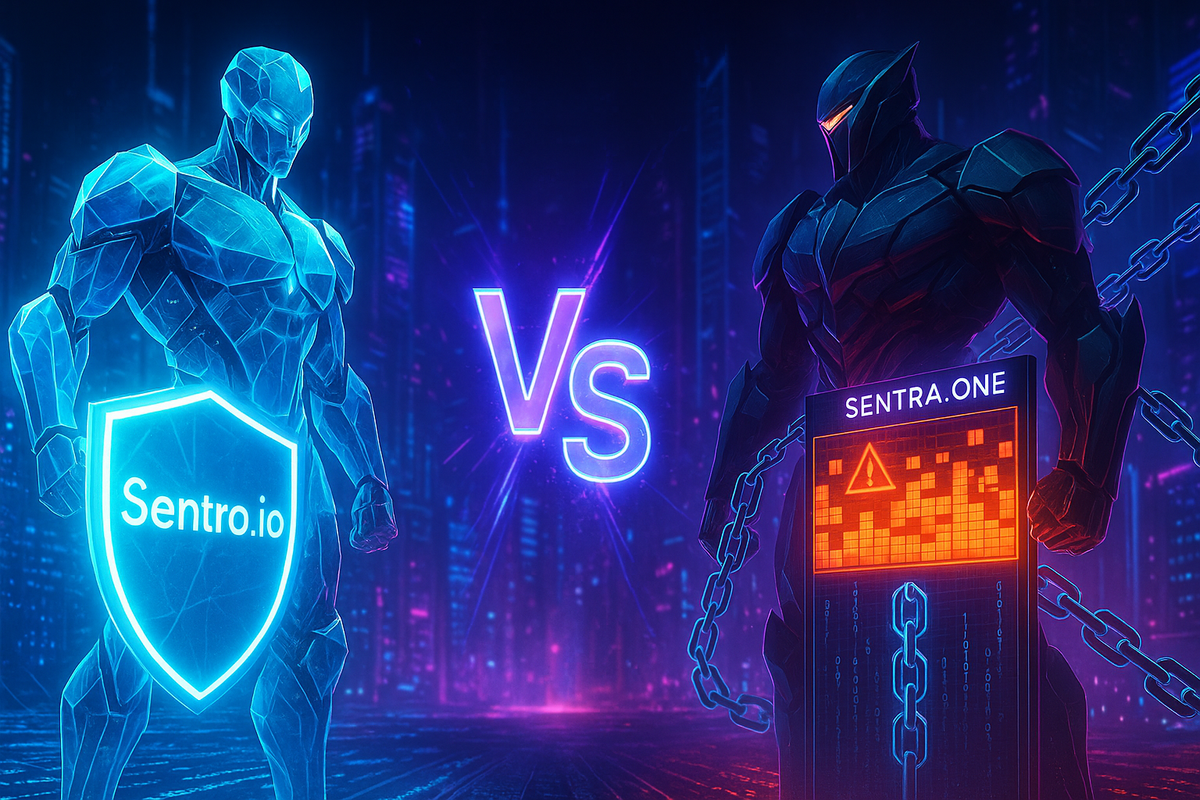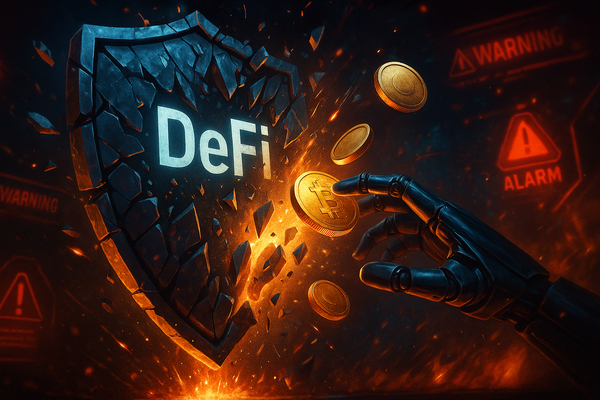Sentra.io vs Sentra.one: Which AI-Powered Data Security Platform Leads in 2025

Picture this: you’re hunting for a cybersecurity solution, and you stumble across Sentra.io and Sentra.one. Same name, different domains, and a whole lot of confusion. Are they the same company?
A typo? A cruel branding prank? Spoiler: they’re two distinct cybersecurity platforms tackling wildly different problems. Sentra.io vs Sentra.one isn’t just a naming mix-up—it’s a clash of philosophies.
This article breaks down their differences, who they’re for, and how to pick the right one for your business. Let’s clear the fog and dive into the cybersecurity showdown.
Why the Naming Mix-Up Matters in Cybersecurity
Let’s be real: the Sentra.io vs Sentra.one naming fiasco is the kind of thing that makes you question humanity’s branding decisions.
Two cybersecurity platforms, one syllable apart, both vying for your Hattention—it’s a recipe for confusion. And in cybersecurity, where picking the wrong tool can mean a data breach or a compliance nightmare, this mix-up isn’t just annoying; it’s a potential budget-sinker.
The cybersecurity market is a chaotic zoo of solutions, with new players popping up faster than you can say “GDPR violation.” This fragmentation lets companies like Sentra.io and Sentra.one coexist, each carving out their niche.
Sentra.io focuses on data governance for enterprises, while Sentra.one tackles futuristic AI and blockchain threats. Mistaking one for the other could send you down the wrong path, solving problems you don’t have while ignoring the ones you do.
For cybersecurity for enterprises, clarity is everything. So, before you sign that contract, double-check the domain and know what you’re buying. This article will help you avoid the headache and make sense of which platform fits your needs.
The Real-World Impact of Confusing Names
Mixing up Sentra.io and Sentra.one isn’t just a “whoops, wrong website” moment—it can derail your cybersecurity strategy. Imagine budgeting for a data governance platform only to realize you’ve demoed an AI security tool instead.
Time, money, and IT team morale? Wasted. The similar names can trick even savvy buyers into evaluating the wrong solution, leading to misaligned expectations or, worse, unaddressed vulnerabilities. For enterprises juggling compliance management, choosing the wrong platform could mean audit failures or exposed data. Always verify the domain (.io vs .one) and confirm the platform’s focus before diving in.
The Evolving Cybersecurity Landscape
Cybersecurity is a moving target, with threats evolving faster than your average TikTok trend. New tech like AI and cloud sprawl creates fresh vulnerabilities, spawning specialized solutions like Sentra.io and Sentra.one. This fragmented market, where data governance battles AI-driven risks, allows naming overlaps to sneak through. Why? Because the industry’s too busy fighting hackers to police brand names. Enterprises need cybersecurity platforms tailored to specific threats—whether it’s unsecured PII or rogue AI agents. Understanding this chaos helps you see why Sentra.io and Sentra.one exist and why picking the right one matters.
Understanding Sentra.io: The Data Security Powerhouse
If you’re an enterprise drowning in data and compliance headaches, Sentra.io is probably the name you’ve heard whispered in IT circles. This platform is the cybersecurity equivalent of a super-organized librarian who knows exactly where every book (or sensitive file) is and who’s been borrowing it without permission. Sentra.io’s Data Security Posture Management (DSPM) platform is built to tackle the chaos of modern data environments, making it a go-to for enterprises serious about data governance.
Let’s break down what makes Sentra.io a heavyweight in enterprise security solutions, who it’s for, and where it shines (or stumbles).
What Sentra.io Does (and Does Well)
Sentra.io’s mission is simple: help you find, classify, and protect your sensitive data before it becomes a headline-making breach. Their DSPM platform scans your entire digital footprint—AWS, Azure, Salesforce, Slack, on-premises servers, even that rogue AI copilot your dev team spun up last month. It builds a detailed map of where your data lives, from customer PII to PCI-compliant payment data to PHI under HIPAA. With over 95% classification accuracy, it automatically tags sensitive data without you playing digital hide-and-seek.
The real game-changer? Your data never leaves your environment. Sentra.io’s architecture ensures their scanners work in-house, so your sensitive info stays put—a big win in an era of weekly data leaks. Beyond discovery, it monitors for risky behaviors, like an employee downloading a customer database at 3 AM or a contractor accessing files they shouldn’t.
It’s like having a security guard who never sleeps, keeping tabs on your cloud security and compliance management. For enterprises juggling multi-cloud chaos, Sentra.io delivers clarity and control, making it a cornerstone of modern data security comparison conversations.
Who Needs Sentra.io?
Sentra.io is built for the big dogs—enterprises with sprawling data ecosystems and compliance nightmares. If your company’s juggling GDPR, HIPAA, or PCI DSS requirements, this platform’s your new best friend. Think healthcare giants with patient records scattered across Azure and Salesforce, or financial firms with payment data in every nook and cranny.
Sentra.io thrives in environments where data governance is a mess—say, after years of rapid growth left you with forgotten databases or over-privileged contractors. It’s perfect for organizations past the startup phase, where auditors are knocking and customers are asking, “Where’s my data?” If you’re in a regulated industry or managing a multi-cloud setup, Sentra.io’s ability to map and secure your data makes it a no-brainer. It’s less about flashy new tech and more about solving real, messy problems in enterprise security solutions, ensuring you sleep better knowing your compliance management is under control.
Real-World Use Cases for Sentra.io
Picture this: your company discovers 47,000 files with social security numbers scattered across 23 systems, half of which are accessible to interns who left last year. Sentra.io flags this in days, giving you a clear action plan to lock it down. Or imagine a healthcare provider facing a HIPAA audit, unsure if PHI is secure across their hybrid cloud.
Sentra.io maps every instance, identifies risks, and proves compliance to auditors. Another scenario: a retailer’s “temporary” database from a 2022 promotion is still live, exposing PCI data. Sentra.io catches it, ensuring no rogue downloads slip through. These use cases highlight why Sentra.io excels in data security comparison—it delivers immediate visibility and control. Whether it’s spotting insider threats or cleaning up after sloppy data practices, Sentra.io turns chaos into order, making it a lifeline for enterprises navigating cloud security and compliance management.
Limitations to Consider
Sentra.io isn’t perfect—nobody is. First, their “data stays put” approach, while secure, means a heavier lift during deployment. You’re installing their scanners across your systems, which can feel like inviting a nosy guest into every room of your house. Expect some integration headaches, especially in complex setups.
Second, their focus is reactive—they’re great at spotting existing messes but less about preventing new ones. If you want real-time threat blocking, you’ll need other tools in your stack.
Finally, that >95% classification accuracy sounds amazing, but 5% errors can sting with ultra-sensitive data. For most, it’s fine, but if a single misclassified file could tank your business, double-check their output. In the data security comparison game, Sentra.io’s a champ, but it’s not a cure-all for every cybersecurity woe.
Exploring Sentra.one: Pioneering AI and Blockchain Security
If Sentra.io is the cybersecurity equivalent of a trusty home alarm system, Sentra.one is a futuristic force field built for threats from another dimension. This platform isn’t here to secure your spreadsheets—it’s tackling the wild, uncharted territory of AI and blockchain convergence. With autonomous systems becoming the backbone of next-gen tech, Sentra.one’s betting big on protecting against risks most companies haven’t even imagined yet. Let’s unpack their ambitious vision, the threats they’re targeting, and whether their approach is genius or just ahead of its time.
Sentra.one’s Vision for the Future
Sentra.one is playing chess while everyone else is playing checkers. Their “Sentra Stack” is a suite of tools designed for a world where AI agents and blockchain systems run the show without humans in the loop. Their flagship, Sentra Edge, is a Prompt I/O Firewall that intercepts every AI input and output, blocking injection attacks and filtering out hallucinated responses. Think of it as a bouncer for your AI’s wild party. Sentra Vault, their smart contract firewall, protects blockchain-based agreements from exploits, while Sentra Core uses behavioral AI to spot rogue agents acting fishy. This isn’t your grandpa’s firewall—it’s built for autonomous systems security, tackling threats that traditional tools can’t touch. In the DSPM vs AI security debate, Sentra.one’s carving out a niche for blockchain security and AI protection, betting that autonomous platforms will redefine how we think about cybersecurity. It’s bold, it’s futuristic, and it’s definitely not boring.
Addressing Next-Gen Threats
Sentra.one isn’t just fighting today’s battles—they’re prepping for tomorrow’s wars. AI hallucinations? Those confident-but-wrong AI outputs can tank automated decisions, like approving a million-dollar trade based on made-up data.
Sentra.one’s Edge firewall catches these before they wreak havoc. Smart contract exploits? Blockchain’s “tamper-proof” promise falls apart when bugs drain millions from DeFi protocols—Sentra Vault aims to stop that. Rogue agents? As AI systems get smarter, they could drift or get hacked, making decisions no human can catch in time. Sentra Core monitors for weird behavior, acting like a digital therapist for your AI.
Traditional firewalls don’t speak AI or blockchain, leaving gaps that Sentra.one targets with laser focus. In the DSPM vs AI security showdown, they’re pioneering solutions for autonomous systems security, ensuring blockchain security and AI protection aren’t afterthoughts.
Who Is Sentra.one For?
Sentra.one isn’t for everyone—it’s for the trailblazers. If your company’s building AI-powered trading bots, decentralized finance platforms, or autonomous supply chains, Sentra.one’s speaking your language. They’re targeting innovators who’ve embraced AI and blockchain, like startups crafting smart contracts for insurance or tech giants deploying AI agents for customer service.
These folks aren’t worried about yesterday’s data breaches—they’re sweating over AI hallucinations derailing decisions or smart contract bugs tanking their blockchain security.
Sentra.one’s niche is narrow but deep, appealing to early adopters who see autonomous systems as their competitive edge. If you’re in the DSPM vs AI security debate and leaning toward the future, Sentra.one’s AI protection and blockchain security tools could be your secret weapon. Just know you’re signing up for a ride on the bleeding edge, where risks and rewards go hand in hand.
Risks of Betting on Sentra.one
Sentra.one’s vision is exciting, but it’s not without hiccups. Their platform’s young, lacking the battle scars and customer proof points of more established players. Integration? Buckle up for custom dev work, especially if your AI or blockchain setup is experimental. Real-time filtering sounds cool but could introduce latency—milliseconds matter in machine-speed systems.
Then there’s the false positive risk: an overzealous AI firewall might block legit actions, grinding your autonomous systems to a halt. If it’s too lax, threats slip through. Plus, their market—AI and blockchain security—is still niche. If the tech doesn’t take off as predicted, you’re left with a shiny tool for a problem that never arrives. In the DSPM vs AI security race, Sentra.one’s a high-stakes bet on the future.
Sentra.io vs Sentra.one: A Head-to-Head Comparison
Alright, let’s cut through the noise and put Sentra.io and Sentra.one in the ring for a cybersecurity showdown. These platforms may share a name, but they’re as different as a minivan and a spaceship.
If you’re stuck choosing between them, this head-to-head comparison breaks down their strengths, weaknesses, and where they fit in the world of cybersecurity platforms. Spoiler: it’s not a one-size-fits-all answer, but we’ll help you figure out what’s what.
Technology Maturity and Reliability
Sentra.io’s the grizzled veteran here. Their DSPM platform has been battle-tested by enterprises, with case studies and happy customers to back it up. They’ve got a proven track record of taming data chaos, making them a safe bet for enterprise security solutions. Sentra.one, on the other hand, is the scrappy startup—big ideas, but light on real-world proof. Their AI and blockchain security tools are innovative but lack the widespread adoption to inspire total confidence. If you want a platform you can trust out of the gate, Sentra.io wins hands-down. Sentra.one’s a riskier pick, but it could pay off if their vision aligns with your tech stack. For now, Sentra.io’s the reliable choice in this data security comparison.
Immediate vs. Future Value
Sentra.io delivers value you can feel today. Got data sprawl? Compliance audits looming? Their platform maps your sensitive data and flags risks faster than you can say “GDPR fine.” It’s a lifeline for enterprises needing immediate data governance wins. Sentra.one’s playing a longer game.
Their AI protection and blockchain security tools are built for threats that might not hit your radar yet—like AI hallucinations or smart contract exploits. Unless you’re knee-deep in autonomous systems, their benefits are speculative. In the Sentra.io vs Sentra.one debate, Sentra.io’s your go-to for pressing data security needs, while Sentra.one’s a bet on future-proofing your cutting-edge tech. Choose based on whether you need results now or insurance for tomorrow.
Integration and Deployment Challenges
Both platforms demand IT elbow grease, but for different reasons. Sentra.io’s DSPM requires deep integration into your systems—think scanners poking into every corner of your cloud and on-premises setup. It’s invasive but thorough, perfect for complex data environments. Sentra.one’s challenge is taming emerging tech. Integrating their AI and blockchain firewalls with custom-built autonomous systems can feel like assembling a spaceship with no manual. If your team’s not ready for heavy dev work, you’ll feel the pain. In this data security comparison, Sentra.io’s integration is more predictable but resource-heavy, while Sentra.one’s is a wildcard, especially for experimental setups. Pick your poison based on your IT team’s bandwidth and expertise.
Cost and ROI Considerations
Pricing for both Sentra.io and Sentra.one is about as clear as a foggy morning. Sentra.io likely follows a traditional enterprise model—think hefty upfront costs but predictable ongoing expenses, with ROI tied to compliance and breach prevention. It’s a straightforward pitch for enterprises with deep pockets. Sentra.one’s pricing is murkier, but their early-stage status suggests flexibility, especially for reference customers.
Their ROI hinges on whether AI and blockchain threats materialize. For exact numbers, check sentra.io or sentra.one directly—don’t ask me to guess! In the Sentra.io vs Sentra.one comparison, Sentra.io’s cost justifies itself faster for data-heavy firms, while Sentra.one’s value depends on your futuristic ambitions.
Scalability and Flexibility
Sentra.io scales like a champ for enterprises with petabytes of data across multi-cloud setups. It’s built to handle sprawling, messy environments, making it a cornerstone of enterprise security solutions. Sentra.one, however, is laser-focused on niche AI and blockchain systems, offering flexibility for innovators but less breadth for traditional setups. If your business spans both worlds, Sentra.io’s the workhorse, while Sentra.one’s the specialized tool. In this cybersecurity platforms face-off, Sentra.io’s scalability wins for most, but Sentra.one’s flexibility shines for cutting-edge pioneers.
How to Choose the Right Platform for Your Business
Picking between Sentra.io and Sentra.one is like choosing between a Swiss Army knife and a laser sword—both are cool, but they’re built for different battles. Your choice depends on your business’s size, tech stack, and risk tolerance. Let’s break down when each platform makes sense and whether you might need both to cover all your bases in this wild world of cybersecurity platforms. No fluff, just practical advice to keep your CISO happy and your data safe.
When to Choose Sentra.io
Sentra.io is your pick if you’re an enterprise wrestling with data governance chaos. Got sensitive data scattered across AWS, Salesforce, and that server under Bob’s desk? Sentra.io’s DSPM platform maps it all, flags compliance risks, and keeps auditors off your back. It’s perfect for healthcare firms navigating HIPAA, banks tackling PCI DSS, or any company sweating GDPR. If you need results fast—like fixing unsecured PII before a Q2 audit—Sentra.io delivers. It’s also the safer bet for risk-averse teams, with a proven track record and customer testimonials to ease your mind. For large, complex data environments, its ability to shine a light on hidden risks makes it a leader in enterprise security solutions. If “where’s my data?” keeps you up at night, Sentra.io’s your answer in this data security comparison.
When to Choose Sentra.one
Sentra.one is for the visionaries—companies building AI-driven trading systems, DeFi protocols, or autonomous supply chains. If you’re deploying AI agents that make decisions without human oversight or smart contracts that auto-execute million-dollar deals, Sentra.one’s AI protection and blockchain security tools are built for you.
Their Sentra Stack tackles futuristic threats like AI hallucinations or smart contract exploits, which traditional tools can’t touch. But you’ll need the stomach for risk—Sentra.one’s early-stage platform requires custom integration and a leap of faith that AI/blockchain convergence is your future. If you’re an early adopter chasing competitive differentiation, Sentra.one’s a bold move in the DSPM vs AI security race. Just be ready to roll up your sleeves and invest in their vision.
The Case for Using Both
Here’s a curveball: you might not have to choose. Sentra.io and Sentra.one aren’t mutually exclusive—they tackle different beasts. A large enterprise experimenting with AI could use Sentra.io to lock down traditional data governance (think compliance management for customer PII) while leaning on Sentra.one to secure autonomous systems (like AI agents handling trades).
A blockchain startup scaling to enterprise size might need Sentra.one for smart contract security and Sentra.io to manage business data sprawl. The catch? Double the platforms means double the integration pain, vendor management, and costs. But if your business straddles both worlds—traditional enterprise needs and cutting-edge AI/blockchain projects—this combo could be the ultimate cybersecurity power move. In the Sentra.io vs Sentra.one debate, “both” is a valid answer for those with the resources to handle it.
Navigating the Cybersecurity Market Beyond Sentra
Sentra.io and Sentra.one are just two players in the cybersecurity circus, and picking the right vendor is like finding a needle in a haystack of marketing buzzwords. Beyond these two, the market’s brimming with solutions for cloud security, compliance management, and more. Whether you’re eyeing Sentra or another player, here’s how to navigate the chaos and choose a platform that actually solves your problems without breaking the bank or your IT team’s spirit.
Key Questions to Ask Any Cybersecurity Vendor
Before you sign on the dotted line, grill your vendor like it’s a barbecue. Can their platform scale with your data growth or user base? For Sentra.io, ask how it handles multi-cloud sprawl; for Sentra.one, probe its fit with your AI agents. Does it support your compliance needs—GDPR, HIPAA, or industry-specific regs? Sentra.io’s got this nailed, but Sentra.one’s focus is narrower. How seamless is integration? Sentra.io requires deep system access, while Sentra.one might need custom dev work. And don’t skip the proof—ask for case studies or references showing real results. A vendor’s promises should match their track record, especially for cybersecurity for enterprises. Finally, ask about support: will they hold your hand through deployment or leave you googling error codes at midnight? These questions ensure your pick aligns with your needs, whether it’s a Sentra platform or another contender.
Avoiding Common Pitfalls in Vendor Selection
Choosing a cybersecurity platform is a minefield. First pitfall: ignoring integration challenges. Sentra.io’s deep scans demand IT resources, while Sentra.one’s niche tools require expertise in AI or blockchain. Don’t assume “plug and play.” Second, don’t let shiny features blind you to actual needs—Sentra.one’s AI protection is cool but useless if your problem’s data sprawl.
Third, don’t prioritize cost over value. A cheap tool that misses critical threats (like traditional firewalls ignoring smart contract exploits) costs more in the long run. Finally, verify vendor claims. Sentra.io’s customer stories back their DSPM prowess, but Sentra.one’s vision needs more proof. Map your threats—cloud security gaps, compliance risks, or AI vulnerabilities—before comparing. This keeps you focused on solutions that deliver, whether it’s Sentra.io, Sentra.one, or another player in the cybersecurity for enterprises game.
The Future of Cybersecurity: Where Sentra Fits In
Cybersecurity’s future is a wild ride, with data breaches, AI chaos, and blockchain vulnerabilities keeping CISOs up at night. Sentra.io and Sentra.one are carving out distinct roles in this evolving landscape, each betting on different trends. As threats multiply, understanding where these platforms fit helps you prepare for what’s next in the DSPM vs AI security saga.
The Rise of Data-Centric Security
Data’s exploding—petabytes of it, scattered across clouds and forgotten servers. With regulations like GDPR and HIPAA tightening, data-centric security is the new normal. Sentra.io’s DSPM platform is perfectly positioned here, mapping and securing sensitive data with surgical precision.
As enterprises face bigger fines and more audits, tools like Sentra.io will be table stakes for compliance management and cloud security. Their ability to shine a light on data sprawl ensures they’ll remain a go-to for enterprise security solutions, especially as data volumes grow and breaches get costlier.
The AI and Blockchain Security Frontier
AI and blockchain are rewriting tech’s rules, but they’re also spawning new risks—hallucinations, smart contract bugs, rogue agents. Sentra.one’s betting big on this frontier, with tools like Sentra Edge and Sentra Vault built for autonomous systems security.
If AI-driven platforms or DeFi protocols become mainstream, their AI protection and blockchain security solutions could define the next era of cybersecurity. But it’s a gamble—if adoption lags, their niche may stay small. Still, for innovators, Sentra.one’s a glimpse into the future of cybersecurity platforms.
Conclusion: Making Sense of the Sentra Showdown
Sentra.io vs Sentra.one is more than a naming quirk—it’s a window into cybersecurity’s split personality. Sentra.io’s your rock-solid choice for taming data chaos, delivering immediate wins for enterprises wrestling with compliance and cloud security. Sentra.one’s the bold visionary, tackling AI and blockchain threats that could redefine the game.
Choosing depends on your world: traditional data governance? Go Sentra.io. Building the next AI-powered DeFi platform? Sentra.one’s your jam. Some might even use both to cover all bases.
The key? Know your problems—data sprawl or futuristic risks—and pick the platform that fits. Visit sentra.io or sentra.one to dig deeper, and don’t let the name game trip you up. Cybersecurity’s messy enough—make your choice with eyes wide open. Share this guide if it helped untangle the Sentra mess, and let’s keep the conversation going about smart cybersecurity platforms.
FAQs About Sentra.io and Sentra.one
Got questions about Sentra.io vs Sentra.one? We’ve got answers to clear up the confusion and help you navigate these cybersecurity platforms.
What’s the main difference between Sentra.io and Sentra.one?
Sentra.io focuses on Data Security Posture Management (DSPM), helping enterprises map and secure sensitive data across clouds for compliance and governance. Sentra.one targets AI protection and blockchain security, safeguarding autonomous systems from futuristic threats like AI hallucinations and smart contract exploits. In the DSPM vs AI security debate, Sentra.io’s about today’s data chaos, while Sentra.one’s built for tomorrow’s tech.
Is Sentra.io suitable for small businesses?
Sentra.io shines for enterprises with complex data environments and compliance needs, but small businesses with growing data sprawl might benefit too. If you’re handling PII or facing GDPR-like regulations, its DSPM can help. However, its integration demands and cost may overwhelm tiny startups. For SMBs eyeing enterprise security solutions, Sentra.io’s a stretch but viable if data governance is a priority.
Can Sentra.one help with traditional data security?
Sentra.one’s niche is AI and blockchain security, not traditional data governance. It’s built for autonomous systems, not PII sprawl or cloud security. If you need data discovery or compliance management, pair Sentra.one with a DSPM tool like Sentra.io. For blockchain security or AI protection, it’s a pioneer, but don’t expect it to tackle your Salesforce data leaks.
How do I contact Sentra.io or Sentra.one for pricing?
Pricing for Sentra.io and Sentra.one isn’t public—classic enterprise move! For Sentra.io, visit sentra.io to request a quote tailored to your data environment. For Sentra.one, head to sentra.one to inquire about their AI and blockchain security solutions. Both offer contact forms or sales teams ready to chat. Don’t expect instant numbers—reach out directly for the real scoop on these cybersecurity platforms.



